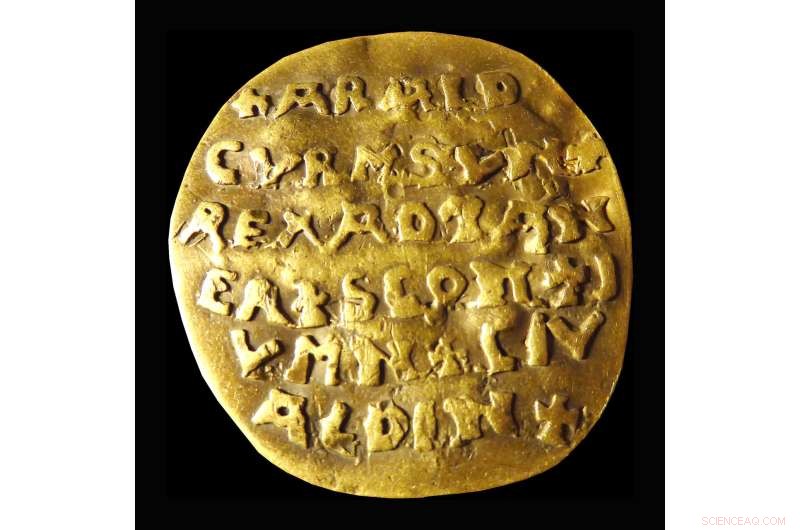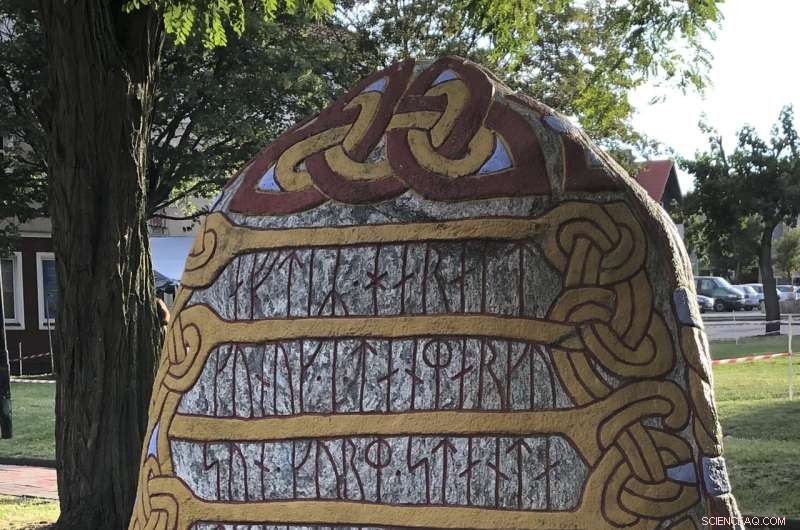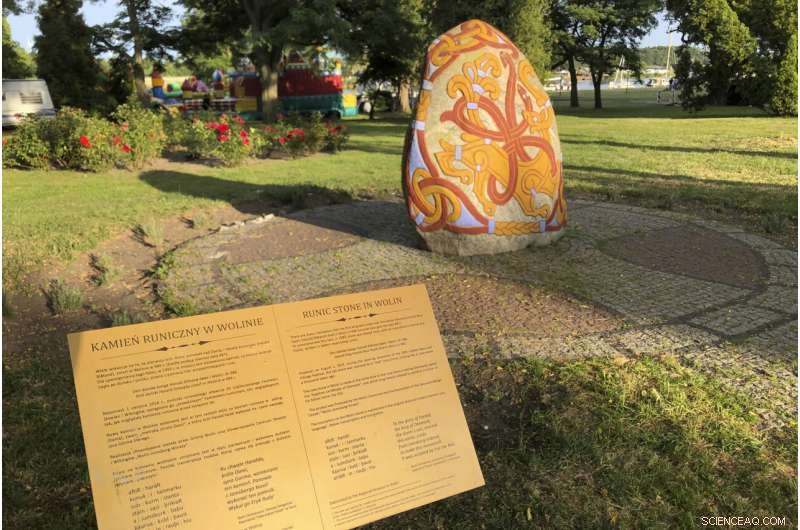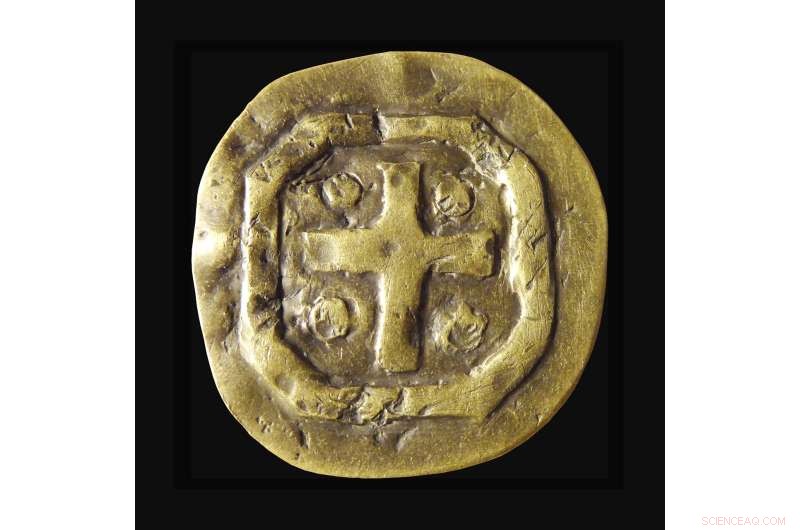
O disco Curmsun dourado do século X com o nome do rei dinamarquês Harald “Bluetooth“ Gormsson (Curmsun em latim), vindo de um túmulo na igreja católica romana em Wiejkowo, Polônia, fotografado em Malmo, Suécia, em 2015. O Bluetooth a tecnologia de link sem fio recebeu o nome do rei. Mais de 1.000 anos após sua morte no que hoje é a Polônia, um rei dinamarquês cujo apelido é conhecido pelo mundo através da tecnologia Bluetooth está no centro de uma disputa arqueológica. Crédito:Sven Rosborn via AP
Mais de 1.000 anos após sua morte no que hoje é a Polônia, um rei europeu cujo apelido sobrevive através da tecnologia sem fio está no centro de uma disputa arqueológica.
Crônicas da Idade Média dizem que o rei Harald "Bluetooth" Gormsson da Dinamarca adquiriu seu apelido por cortesia de um dente, provavelmente morto, que parecia azulado. Uma crônica da época também diz que o rei viking foi enterrado em Roskilde, na Dinamarca, no final do século X.
Mas um arqueólogo sueco e um pesquisador polonês afirmaram recentemente em publicações separadas que localizaram seu local de sepultamento mais provável na vila de Wiejkowo, em uma área do noroeste da Polônia que tinha laços com os vikings na época de Harald.
Marek Kryda, autor do livro "Viking Poland", disse à Associated Press que um "montículo pagão" que ele afirma ter localizado sob a igreja católica romana do século 19 de Wiejkowo provavelmente contém os restos mortais do rei. Kryda disse que imagens geológicas de satélite disponíveis em um portal do governo polonês revelaram uma forma rotunda que parecia um túmulo viking.
Mas o arqueólogo sueco Sven Rosborn, diz que Kryda está errado porque Harald, que se converteu do paganismo ao cristianismo e fundou igrejas na área, deve ter recebido uma sepultura apropriada em algum lugar do cemitério. A Igreja da Imaculada Conceição da Bem-Aventurada Virgem Maria de Wiejkowo fica no topo de uma pequena colina redonda.

Uma vista de uma pedra de 2014 com inscrição rúnica em memória do rei dinamarquês do século 10 Harald “Bluetooth” Gormsson, em Wolin, Polônia, sábado, 30 de julho de 2022. Mais de 1.000 anos após sua morte no que hoje é a Polônia, um rei dinamarquês cujo apelido é conhecido pelo mundo através da tecnologia Bluetooth está no centro de uma disputa arqueológica. Um pesquisador polonês e um arqueólogo sueco afirmam que localizaram o provável local de sepultamento do rei Harald Bluetooth Gormsson em uma pequena vila no noroeste da Polônia, uma área que já teve laços com os vikings. Crédito:AP Photo Monika Scislowska
Historiadores do Museu Nacional Dinamarquês em Copenhague dizem estar familiarizados com a "sugestão" de que Wiejkowo é o local de sepultamento de Harald.
Rosborn detalhou sua pesquisa no livro de 2021 "The Viking King's Golden Treasure" e Kryda desafiou algumas das descobertas do sueco em seu próprio livro publicado este ano.
Harald, que morreu em 985, provavelmente em Jomsborg - que se acredita ser a cidade polonesa de Wolin agora - foi um dos últimos reis vikings a governar o que hoje é a Dinamarca, o norte da Alemanha e partes da Suécia e da Noruega. Ele espalhou o cristianismo em seu reino.
Swedish telecommunications company Ericsson named its Bluetooth wireless link technology after the king, reflecting how he united much of Scandinavia during his lifetime. The logo for the technology is designed from the Scandinavian runic letters for the king's initials, HB.

A view of a 2014 stone with runic inscription in memory of Danish 10th century King Harald “Bluetooth” Gormsson, in Wolin, Poland, Saturday, July 30,2022. More than 1,000 years after his death in what is now Poland, a Danish king whose nickname is known to the world through the Bluetooth technology is at the center of an archeological dispute. A Polish researcher and a Swedish archeologist claim that they have pinpointed the probable burial site for King Harald Bluetooth Gormsson in a small village in northwestern Poland, an area that once had ties with the Vikings. Credit:AP Photo Monika Scislowska
Rosborn, the former director of Sweden's Malmo City Museum, was spurred on his quest in 2014 when an 11-year-old girl sought his opinion about a small, soiled coin-like object with old-looking text that had been in her family's possession for decades.
Experts have determined that the cast gold disk that sparked Maja Sielski's curiosity dated from the 10th century. The Latin inscription on what is now known as the "Curmsun disk" says:"Harald Gormsson (Curmsun in Latin) king of Danes, Scania, Jomsborg, town Aldinburg."
Sielski's family, who moved to Sweden from Poland in 1986, said the disk came from a trove found in 1841 in a tomb underneath the Wiejkowo church, which replaced a medieval chapel.
The Sielski family came into the possession of the disk, along with the Wiejkowo parish archives that contained medieval parchment chronicles in Latin, in 1945 as the former German area was becoming part of Poland as a result of World War II.
-

The Roman Catholic church where it is believed that Danish King Harald Gormsson was buried, in Wiejkowo, Poland, Saturday, July 30, 2022. More than 1,000 years after his death in what is now Poland, a Danish king whose nickname is known to the world through the Bluetooth technology is at the center of an archeological dispute. A Polish researcher and a Swedish archeologist claim that they have pinpointed the probable burial site for King Harald Bluetooth Gormsson in a small village in northwestern Poland, an area that once had ties with the Vikings. Credit:AP Photo Monika Scislowska
-

A view inside the Roman Catholic church where it is believed that Danish King Harald Gormsson was buried, in Wiejkowo, Poland, Saturday, July 30, 2022. More than 1,000 years after his death in what is now Poland, a Danish king whose nickname is known to the world through the Bluetooth technology is at the center of an archeological dispute. A Polish researcher and a Swedish archeologist claim that they have pinpointed the probable burial site for King Harald Bluetooth Gormsson in a small village in northwestern Poland, an area that once had ties with the Vikings. Credit:AP Photo Monika Scislowska
-

The 10th century golden Curmsun disc with the name of Danish King Harald “Bluetooth“ Gormsson (Curmsun in Latin) on it, coming from a tomb at the Roman Catholic church in Wiejkowo, Poland, photographed in Malmo, Sweden, in 2015. The Bluetooth wireless link technology is named after the king. More than 1,000 years after his death in what is now Poland, a Danish king whose nickname is known to the world through the Bluetooth technology is at the center of an archeological dispute. Credit:Sven Rosborn via AP
A family member who knew Latin understood the value of the chronicles—which dated as far back as the 10th century—and translated some of them into Polish. They mention Harald, another fact linking the Wiejkowo church to him.
The nearby Baltic Sea island and town of Wolin cultivates the region's Viking history:it has a runic stone in honor of Harald Bluetooth and holds annual festivals of Slavs and Vikings.
Kryda says the Curmsun disk is "phenomenal" with its meaningful inscription and insists that it would be worth it to examine Wiejkowo as Harald's burial place, but there are no current plans for any excavations.
+ Explorar mais Archaeologists find silver treasure on German Baltic island
© 2022 The Associated Press. Todos os direitos reservados. Este material não pode ser publicado, transmitido, reescrito ou redistribuído sem permissão.





